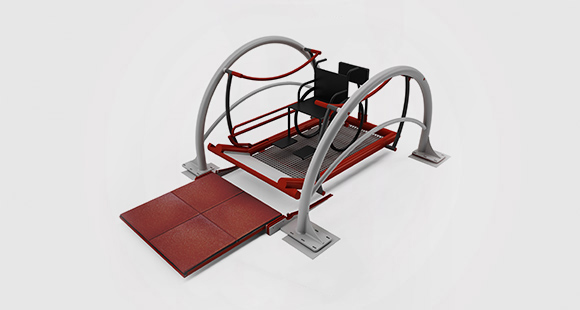Medical devices We design to help
INSLUSIVE SWING IN THE PLAYGROUND
Is it possible to install a swing for disabled in the public playground? Is there a solution for safe and conforming standards reconciliation of needs of both groups – disabled and without disabilities?
The swing in the playground is one of the basic pieces of equipment. It turns out, however, that such trivial fun as swinging is not available to some playground users.
Fake accessibility
Unfortunately playgrounds still lack devices available to users with various levels of ability, physical and intelectual. There are still few devices available for people on wheelchairs, and if they appear, they are not sufficiently adapted to the various needs of access and operation. Not always the possibility of using them independently or using a guardian who will start the device exists. Instead of creating accessible playgrounds, the devices only for disabled or only for fully abled people are being picked, dividing users instead of connecting them.
Dangerous swings
There must be a ramp on each swing that is ment for the wheelchair to enter. Swinging with an open ramp threatens the safety of bystanders outside the device. In order to be stable and safe, the ramp must be able to be raised and blocked both by a non-disabled person and in a wheelchair, because not everyone wants to use a guardian. Unfortunately, the weight of the ramps and the way of their lifting often preclude this, making the solution a threat to safety.
Another problem is where the ramp meets the surface surrounding the device. It is not physically possible to eliminate the risk of crushing in such a place. If another child stands close and the ramp is uncontrolled while lowering, an accident will occur.
There is also not enough space for two people on the platform on most of available swings on the market. This is important for heavier disabled people who are physically unable to operate the device but would like to use it. In such a situation, the guardian, parent, sibling, colleague or friend should be able to perform this activity, but in a way that will not make the person in a wheelchair feel inertial - preferably when users play together on one platform while communicating at the same time. and making eye contact.
Swings on rigid strands are a huge threat, which can, firstly, be hit by bystanders, and secondly, having a variable distance of the driveway from the ground, they can encourage non-disabled people to lower their lower limbs from the platform while swinging. The changing distance and momentum of the swing can break and crush the baby's limbs.
No for swings?
Is it possible to create a swing swing that will meet the needs of non-disabled people and those in wheelchairs, while being in line with the PN-EN 1176 standard and completely safe on a public playground? The answer is yes, but it’s difficult.
Most of the swing swings that allow people in wheelchairs to play, endanger the safety of non-disabled people.
Swings intended for people in wheelchairs should not be installed in public playgrounds for safety reasons. The solution is not to enclose the devices with fences with the indication that the device is only suitable for people on wheelchairs, because instead of accessibility, the so-called ghetto, clearly pointing to the "otherness" of the users.
Such devices can be mounted on closed, so-called special playgrounds located at rehabilitation centers and other facilities providing care for people with disabilities, supervised and not public.
Alternative swinging
Are there alternatives, then, when it comes to accessibility and equal right to play for all swings?
Such swings may be located in outdoor gyms, where, by design, there are devices intended for users over 14 years of age, provided that they comply with the standard not for playgrounds, but for outdoor gyms (PN-EN 16630: 2015-06).
Such a device may be located near the playground, but architecturally separated in a clear way, so that there is no doubt that it is not a playground area. Therefore, such a swing does not need to be fenced in the area of an outdoor gym.
If, however, for safety reasons, due to the proximity of the playground, the designer decides to use a fence, it is worth using the option of planting a dense hedge (preferably blooming in spring or evergreen), but there are also other ways, such as using posts with ropes or interesting design barriers that will separate the device, without stigmatizing users.
Example of different attitude towards desibning the fence. Picture: Łazienki Królewskie, inclusive playground, Warsaw, Poland
Using fence and plants. Picture: materials of the foundation Dzieci Wuja Toma in Aleksandria Druga, Poland.
Locating the swing aside the playground, on the outdoor gym. TERMA Inclusive swing in Dillingen, Germany, "Pro-Inklusionsschaukel" projekct lead by Peter Haffner, Germany.



